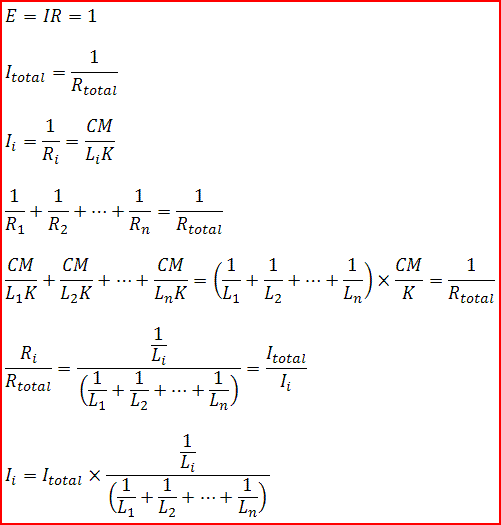Alex electrical student
Member
Where can i find a good formula for what amperage each wire will carry if you are doing parallel feeder runs?
I found a formula in (Electrical Wiring Commercial) but just by looking at it, i can tell that it is wrong.
In the (Electrical Wiring Commercial), they gave this problem.
A 1600 ampere service consists of four conduits, each containing four 600 kcmil Type THWN copper conductors. The allowable ampacity of this conductor is 420 amperes. When the service is operating at 1600 ampere, what is the current in each of four parallel sets of conductors, if their lengths are 20 ft., 21 ft, 22 ft, 23 ft?
To me, above formula doesn't look correct because it's missing some factors. Try out theses wire lengths. 1 ft. 21 ft. 22 ft. and 23 ft.
(1/67) x 1600 = 23.88 A
(21/67) x 1600 = 501.5 A
(22/67) x 1600 = 525.4 A
(23/67) x 1600 = 549.25 A
See one wire carries 24 A and all the other carry 500+ amps. It's wrong.
Some other factors that the formula is missing out.
If a short wire carries more amperage, it heats up which means the resistance goes, which then makes the amperage go down. The longer wires stay cool because they carry less amperage which gives them less resistance so then they start to carry more amperage when the shorter wire heats up.
If any one has a good formula that includes all the factors please i would like to have it. I would really appreciate it.
I found a formula in (Electrical Wiring Commercial) but just by looking at it, i can tell that it is wrong.
In the (Electrical Wiring Commercial), they gave this problem.
A 1600 ampere service consists of four conduits, each containing four 600 kcmil Type THWN copper conductors. The allowable ampacity of this conductor is 420 amperes. When the service is operating at 1600 ampere, what is the current in each of four parallel sets of conductors, if their lengths are 20 ft., 21 ft, 22 ft, 23 ft?
Books solution--- (length of wire / length of wires combined) x Amps
total length = 20 + 21 + 22 + 23 = 86 ft
The current in each set is inversely proportional to the resistance, which is proportional to the conductor's length. The proportional resistance of each set is
(20/86) x 1600 = 372.09 A
(21/86) x 1600 = 390.6 A
(22/86) x 1600 = 409.3 A
(23/86) x 1600 = 427.9 A
Since current is inversely proportional to resistance, the currents would be 428, 409, 390, and 372.
total length = 20 + 21 + 22 + 23 = 86 ft
The current in each set is inversely proportional to the resistance, which is proportional to the conductor's length. The proportional resistance of each set is
(20/86) x 1600 = 372.09 A
(21/86) x 1600 = 390.6 A
(22/86) x 1600 = 409.3 A
(23/86) x 1600 = 427.9 A
Since current is inversely proportional to resistance, the currents would be 428, 409, 390, and 372.
To me, above formula doesn't look correct because it's missing some factors. Try out theses wire lengths. 1 ft. 21 ft. 22 ft. and 23 ft.
(1/67) x 1600 = 23.88 A
(21/67) x 1600 = 501.5 A
(22/67) x 1600 = 525.4 A
(23/67) x 1600 = 549.25 A
See one wire carries 24 A and all the other carry 500+ amps. It's wrong.
Some other factors that the formula is missing out.
If a short wire carries more amperage, it heats up which means the resistance goes, which then makes the amperage go down. The longer wires stay cool because they carry less amperage which gives them less resistance so then they start to carry more amperage when the shorter wire heats up.
If any one has a good formula that includes all the factors please i would like to have it. I would really appreciate it.
Last edited:

